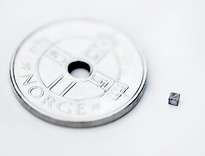The creation of a 3-D nanocone-based solar cell platform has allowed a team of scientists to boost the light-to-power conversion efficiency of photovoltaics by nearly 80 percent.
The team led by Oak Ridge National Laboratory’s Jun Xu discovered the technology substantially overcomes the problem of poor transport of charges generated by solar photons.
These charges, negative electrons and positive holes, typically become trapped by defects in bulk materials and their interfaces and degrade performance.
“To solve the entrapment problems that reduce solar cell efficiency, we created a nanocone-based solar cell, invented methods to synthesize these cells and demonstrated improved charge collection efficiency,” Xu, a member of ORNL’s Chemical Sciences Division, said.
The new solar structure consists of n-type nanocones surrounded by a p-type semiconductor. The n-type nanoncones are made of zinc oxide and serve as the junction framework and the electron conductor.
The p-type matrix is made of polycrystalline cadmium telluride and serves as the primary photon absorber medium and hole conductor.
With this approach at the laboratory scale, Xu and colleagues were able to obtain a light-to-power conversion efficiency of 3.2 percent compared to 1.8 percent efficiency of conventional planar structure of the same materials.
“We designed the three-dimensional structure to provide an intrinsic electric field distribution that promotes efficient charge transport and high efficiency in converting energy from sunlight into electricity,” Xu said.
Key features of the solar material include its unique electric field distribution that achieves efficient charge transport; the synthesis of nanocones using inexpensive proprietary methods; and the minimization of defects and voids in semiconductors.
The latter provides enhanced electric and optical properties for conversion of solar photons to electricity.
Because of efficient charge transport, the new solar cell can tolerate defective materials and reduce cost in fabricating next-generation solar cells.











